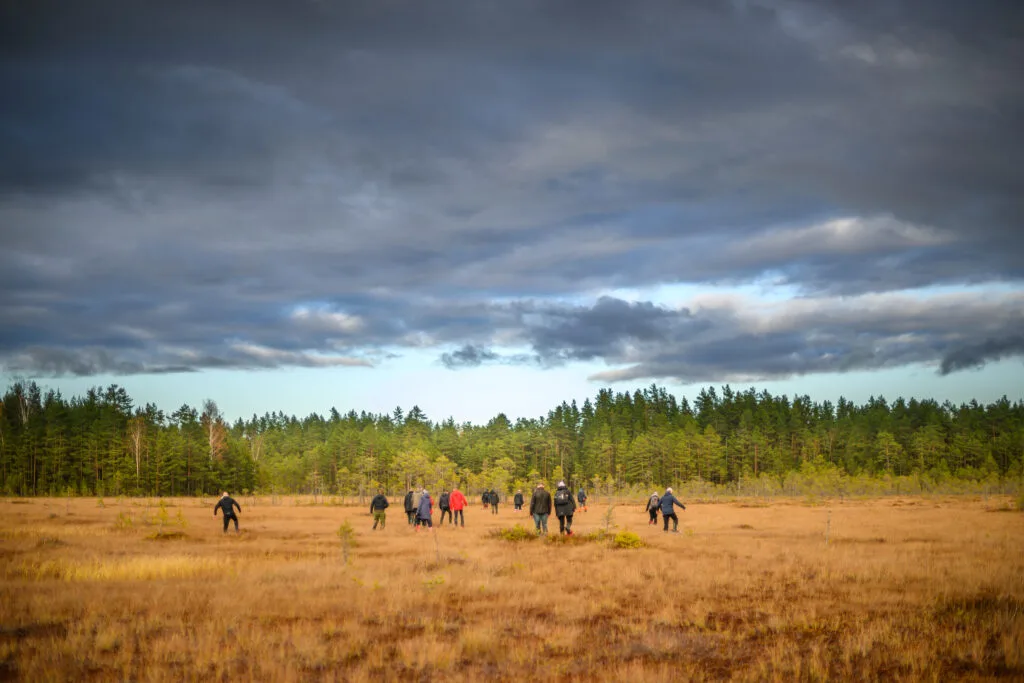Alutaguse National Park is the youngest in Estonia. It is distinguished from Lahemaa national Park and Soomaa by its scattered territory. The center of the national park is a cluster of swamps, distinguished by somewhat unique phenomena of inland dunes, in the local dialect they are called meander scars.
Mainland sand meander scars, rather familiar to the desert terrain, manifest themselves in clusters of Alutaguse bogs, staying away from most of the trails that people walk. The local landscape has become more often spoken about in connection with the creation of the Alutaguse National Park in 2018, because it is here that the only alluvial meander scars in Estonia stretch.
Parade of ’puffed-up pigeons’
No matter how many times I asked my friends, no one saw the meander scars with their own eyes and had no idea what they are. And suddenly, as if by order, the tourist club of Alutaguse organizes in late May, on the day of protected areas, a hike in baste shoes through the Agusalu bogs, where the meander scars show themselves in all their pristine beauty and where you can admire the stunning view of the bog and sand ridge.
If you have never seen meander scars before, and you have not been on a hike in baste shoes, then it’s time to do both at the same time.

We gather before the hike in the parking lot of the nature center in Iisaku, from there the route goes towards Vaikla and then along the forest road to Imatu. We make a small stop before reaching the RMK Agusalu fire pit. The road, sometimes shaking, took about half an hour. The next half hour is spent studying the map and attaching the baste shoes on rubber boots. They need to be adjusted correctly, fitting the leg, then fixed and tightened.
It is not so easy to walk in baste shoes. We are instructed by the Director of the Alutaguse tourist club Ingrid Kuligina: „Normally, we walk with our heels in and our toes slightly out. You can’t go like that far in baste shoes, you can accidentally step on your shoe.“
Walking like club-footed bears – toes in – is also no good. „We should walk like drunks who are trying to keep their balance,“ our instructor continues, and after a short pause tries to clarify the idea. „We are going like Estonian men who have drunk beer from a swamp ledum and resemble German soldiers in armor. We keep our legs parallel and a little apart.“
This combination of beer and armor seems clear to everyone, because despite the clumsy movements, no one’s baste shoes cross. Instructions about the pace of movement were also not in vain: „We move slowly and calmly, feeling like light puffed-up pigeons. I like the bog because you can’t run here. As soon as you run, you will fall deeper than you expect.“
Studying the map, we decide which meander scar we will target at Järvesoo. Ingrid Kuligina promises to take us there in a detour. You cannot go directly as the road will be blocked by a swamp current, or rather, a swampy vein, for beginners, the task is not pleasant. We also agree that we will leave aside the large swamps where wading birds nest in the spring.

Cranberries mixed with hare droppings
The first halt is made, barely reaching the edge of the swamp, where cranberries are reddening among the hare droppings. We try the berries to taste, after the winter cold they are much sweeter than in the fall, but our guide advises not to overdo it: „Of course, in the spring there is less acid in cranberries, and more sugar, but on an empty stomach it is better not to eat a lot of berries, some may feel sick.“

On the crest of the first meander scar we conquered, we see abundance of berries, but they have already passed the bear’s stomach tract. In a joint latrine of nature’s inhabitants, both a badger and one of the predators visited, which is clear from the fur in the droppings. It is possible that there was a wolf, after having dinner of rabbit.
However, our guide does not claim anything, the latrine is too old. “We will still encounter such phenomena because animals are very attracted to the comb of the crest as a toilet. Everyone wants to show that they are the owners here and mark their territory.”
We decide to deviate from the planned itinerary and glance at Imata swamp lake. It is the vicinity of this lake that stands out with an abundance of meander scars. I wonder how about fish in the lake?
„I haven’t seen armies of fishermen here like in Kurtna, but there are fish in the lake. Locals also often saw tapeworm eggs,“ adds Ingrid Kuligina.
The wetland ‘traffic rules’
When we return, the guide reminds us of the rules for walking through a swampy area. „If in normal traffic, the red signal warns you to „stop“ and the green signals „go“, then in the swamp, the greener and brighter, the more water there is.“
The Agusalu swamp clusters are younger than Selisoo, and we won’t see duckweed windows here, but there are a lot of meander scars covered with young pines, which are not present in Selisoo. At the top of the most powerful ridge, we make a longer stop, and from there we have a good overview of the meander scars formed during thousands of years. „When I started working as a guide, we were taught that these are the final moraines, but this theory was disproved,“ begins Ingrid Kuligina her story.

„Then we were told that those were the coastal ramparts of lake Peipus, such as those in Alajõe, Kauksi and other places. But ten years ago, new soil samples were taken – and today there are much better technical opportunities for research – and it turned out that here in Alutaguse are the only meander scars in Estonia. This means that they originated not in the coastal zone, but in the mainland.“
When driving through a swampy area, the meander scar acts as a bridge. Climbing on this natural bridge, you can rest your feet and enjoy the views. High pine forest will give a pleasant shade on a sunny day and will please mushroom and berry pickers.
Born with the wind
But how and when were these meander scars formed? They were formed at the end of the last ice age, when there was a cold desert, and they were shaped under the influence of wind that deposited sedimentary rocks (alluvium). The highest meander scar is 18 m, and the longest stretches for 4 km. There are also small two-meter scars. In total, there are more than 200 of them.
Agusalu meander scars were once inhabited by the Votes people, from whose language the name of the sand ridges came. Linguists offer two versions of the origin of the word meander scars (which is ’mane’ in Estonian and in Russian though sounds like ‘griva’): either from the word „curved“, or from the horse’s ’mane’.
The Agusalu swamp clusters are called the heart of the Alutaguse National Park, because they consist of several parts located in the central zone of the Park, but they are smaller than the largest swamp clusters of Puhatu and Muraka. The „highlight“ of Agusalu are considered meander scars, and we go around six of them.

Returning three hours later to the cars, we find out that they parked on the ridge, and many more meander scars lie on the side of forest roads of Vaikla – Imatu. A memorable picture opens from the car window, too, but still the most spectacular scar view is when it suddenly appears before your eyes out of the swamp surface.
For those who want to stay in the middle of an unusual terrain, there is even the possibility of an overnight stay. You only need to find the RMK Seljandik forest hut on the map.
If you prefer to move around without getting your feet wet, go for a walk on the boardwalk. In the Alutaguse National Park there are two such trails: the RMK Selisoo or Kotka. Both are good. Kotka trail passes close to Iisaku, it has swampy islands and long meander scars, and it offers a diverse landscape. Selisoo hiking trail starting at Väike-Pungerja is remembered for its mysterious water pools covered with duckweed.
A gift to the centennial
The Alutaguse National Park covers an area of 40 hectares intended to protect not only the swamps of Eastern Estonia, but also forests and coastal areas, and even to protect cultural heritage. The Republic of Estonia has made itself a great gift for the centenary of the state.
„For the first time, the idea of creating the Alutaguse reserve arose just 100 years ago, in the early 1920s. At that time, Gustav Vilbaste, an Estonian nature conservationist, came up with the idea of creating the first national park in Estonia in Alutaguse region.
Unfortunately, it did not work at that time. As the creation of the Alutaguse National Park took place on the 100th anniversary of the Republic of Estonia, it is a beautiful gift not only to Ida-Virumaa, but to the whole of Estonia,“ said Siim Kiisler, the former Minister of the Environment.
The Alutaguse area is historically the largest area of coniferous forests and bogs in Estonia. In addition to the impressive swamps, the national park has the longest sandy beach in Estonia and the unique Smolnitsa dunes on the northern coast of Lake Peipsi, the Narva River with the largest flow in Estonia, old rivers and meadows in Struuga, Kurtna lake district with 40 lakes, and one of the most representative broad-leaved pristine forests of Estonia in Poruni.
SIRLE SOMMER-KALDA
Journalist for ’Põhjarannik’ newspaper
„The story is written with the support of the EU Regional Development Fund“








